Correlative Experimental and Theoretical Investigation of the Angle-Resolved Composition Evolution of Thin Films Sputtered from a Compound Mo2BC Target
Abstract
:1. Introduction
2. Materials and Methods
2.1. Experimental Details
2.2. Simulation Details
2.2.1. TRIDYN
2.2.2. Energy Conservation Law Approach
2.2.3. Ab Initio Approach
2.2.4. SIMTRA
3. Results and Discussion
3.1. Experiment
3.2. Simulations
4. Conclusions
Author Contributions
Funding
Acknowledgments
Conflicts of Interest
References
- Bovin, J.O.; O’Keeffe, M.; Stenberg, L. Planar defects in Mo2BC. An electron microscope study. J. Solid State Chem. 1977, 22, 221–231. [Google Scholar] [CrossRef]
- Jeitschko, W.; Nowotny, H.; Benesovsky, F. Die kristallstruktur von Mo2BC. Monatshefte für Chemie und verwandte Teile anderer Wissenschaften 1963, 94, 565–568. [Google Scholar] [CrossRef]
- Emmerlich, J.; Music, D.; Braun, M.; Fayek, P.; Munnik, F.; Schneider, J.M. A proposal for an unusually stiff and moderately ductile hard coating material: Mo2BC. J. Phys. D Appl. Phys. 2009, 42, 185406. [Google Scholar] [CrossRef]
- Bolvardi, H.; Emmerlich, J.; Music, D.; von Appen, J.; Dronskowski, R.; Schneider, J.M. Systematic study on the electronic structure and mechanical properties of X2BC (X = Mo, Ti, V, Zr, Nb, Hf, Ta and W). J. Phys. Condens. Matter 2012, 25, 045501. [Google Scholar] [CrossRef]
- Bolvardi, H.; Emmerlich, J.; Mráz, S.; Arndt, M.; Rudigier, H.; Schneider, J.M. Low temperature synthesis of Mo2BC thin films. Thin Solid Films 2013, 542, 5–7. [Google Scholar] [CrossRef]
- Sarakinos, K.; Alami, J.; Konstantinidis, S. High power pulsed magnetron sputtering: A review on scientific and engineering state of the art. Surf. Coat. Technol. 2010, 204, 1661–1684. [Google Scholar] [CrossRef]
- Ohring, M. Materials Science of Thin Films, 2nd ed.; Academic Press Limited: Cambridge, MA, USA, 1992. [Google Scholar]
- Emmerlich, J.; Högberg, H.; Sasvári, S.; Persson, P.O.; Hultman, L.; Palmquist, J.P.; Jansson, U.; Molina-Aldareguia, J.M.; Czigány, Z. Growth of Ti3SiC2 thin films by elemental target magnetron sputtering. J. Appl. Phys. 2004, 96, 4817–4826. [Google Scholar] [CrossRef]
- Eklund, P.; Joelsson, T.; Ljungcrantz, H.; Wilhelmsson, O.; Czigány, Z.; Högberg, H.; Hultman, L. Microstructure and electrical properties of Ti-Si-C-Ag nanocomposite thin films. Surf. Coat. Technol. 2007, 201, 6465–6469. [Google Scholar] [CrossRef]
- Chen, L.; Holec, D.; Du, Y.; Mayrhofer, P.H. Influence of Zr on structure, mechanical and thermal properties of Ti–Al–N. Thin Solid Films 2011, 519, 5503–5510. [Google Scholar] [CrossRef] [PubMed]
- Eklund, P.; Beckers, M.; Jansson, U.; Högberg, H.; Hultman, L. The Mn+1AXn phases: Materials science and thin-film processing. Thin Solid Films 2010, 518, 1851–1878. [Google Scholar] [CrossRef]
- Neidhardt, J.; Mráz, S.; Schneider, J.M.; Strub, E.; Bohne, W.; Liedke, B.; Moller, W.; Mitter, C. Experiment and simulation of the compositional evolution of Ti-B thin films deposited by sputtering of a compound target. J. Appl. Phys. 2008, 104, 063304. [Google Scholar] [CrossRef]
- Mitterer, C. Borides in thin film technology. J. Solid State Chem. 1997, 133, 279–291. [Google Scholar] [CrossRef]
- Kunc, F.; Musil, J.; Mayrhofer, P.H.; Mitterer, C. Low-stress superhard Ti-B films prepared by magnetron sputtering. Surf. Coat. Technol. 2003, 174, 744–753. [Google Scholar] [CrossRef]
- Shaginyan, L.R.; Mišina, M.; Kadlec, S.; Jastrabik, L.; Mackova, A.; Peřina, V. Mechanism of the film composition formation during magnetron sputtering of WTi. J. Vac. Sci. Technol. A 2001, 19, 2554–2566. [Google Scholar] [CrossRef]
- Jonsson, L.B.; Hedlund, C.; Katardjiev, I.V.; Berg, S. Compositional variations of sputter deposited Ti/W barrier layers on substrates with pronounced surface topography. Thin Solid Films 1999, 348, 227–232. [Google Scholar] [CrossRef]
- Ramarotafika, H.; Lemperiere, G. Influence of a d.c. substrate bias on the resistivity, composition, crystallite size and microstrain of WTi and WTi-N films. Thin Solid Films 1995, 266, 267–273. [Google Scholar] [CrossRef]
- Rogers, B.R.; Tracy, C.J.; Cale, T.S. Compositional variation in sputtered Ti-W films due to re-emission. J. Vac. Sci. Technol. A 1994, 12, 2980–2984. [Google Scholar] [CrossRef]
- Rogers, B.R.; Cale, T.S.; Chang, Y.K. Simulation and experimental study of re-emission during sputter deposition of Ti-W films. J. Vac. Sci. Technol. A 1996, 14, 1142–1146. [Google Scholar] [CrossRef]
- Bergstrom, D.B.; Tian, F.; Petrov, I.; Moser, J.; Greene, J.E. Origin of compositional variations in sputter-deposited TixW1−x diffusion barrier layers. Appl. Phys. Lett. 1995, 67, 3102–3104. [Google Scholar] [CrossRef]
- Rossnagel, S.M.; Yang, I.; Cuomo, J.J. Compositional changes during magnetron sputtering of alloys. Thin Solid Films 1991, 199, 59–69. [Google Scholar] [CrossRef]
- Dirks, A.G.; Wolters, R.A.M.; Nellissen, A.J.M. On the microstructure-property relationship of W-Ti-(N) diffusion barriers. Thin Solid Films 1990, 193, 201–210. [Google Scholar] [CrossRef]
- Willer, J.; Pompl, S.; Ristow, D. Sputter-deposited WBx films. Thin Solid Films 1990, 188, 157–163. [Google Scholar] [CrossRef]
- Simao, R.A.; Costa, A.K.; Achete, C.A.; Camargo Jr, S.S. Magnetron sputtering SiC films investigated by AFM. Thin Solid Films 2000, 377, 490–494. [Google Scholar] [CrossRef]
- Murakami, Y.; Shingyoji, T. Compositional difference between films and targets in sputtering of refractory metal silicides. J. Vac. Sci. Technol. A 1990, 8, 851–854. [Google Scholar] [CrossRef]
- Yamazaki, T.; Ikeda, N.; Tawara, H.; Sato, M. Investigation of composition uniformity of MoSix sputtering films based on measurement of angular-distribution of sputtered atoms. Thin Solid Films 1993, 235, 71–75. [Google Scholar] [CrossRef]
- Liao, M.Y.; Gotoh, Y.; Tsuji, H.; Ishikawa, J. Deposition of vanadium carbide thin films using compound target sputtering and their field emission. J. Vac. Sci. Technol. A 2005, 23, 1379–1383. [Google Scholar] [CrossRef]
- Liao, M.Y.; Gotoh, Y.; Tsuji, H.; Ishikawa, J. Compound-target sputtering for niobium carbide thin-film deposition. J. Vac. Sci. Technol. B 2004, 22, L24–L27. [Google Scholar] [CrossRef]
- Mráz, S.; Emmerlich, J.; Weyand, F.; Schneider, J.M. Angle-resolved evolution of the composition of Cr-Al-C thin films deposited by sputtering of a compound target. J. Phys. D Appl. Phys. 2013, 46, 135501. [Google Scholar] [CrossRef]
- Rueß, H.; to Baben, M.; Mráz, S.; Shang, L.; Polcik, P.; Kolozsvári, S.; Hans, M.; Primetzhofer, D.; Schneider, J.M. HPPMS deposition from composite targets: Effect of two orders of magnitude target power density changes on the composition of sputtered Cr-Al-C thin films. Vacuum 2017, 145, 285–289. [Google Scholar] [CrossRef]
- Walter, C.; Martinez, C.; El-Raghy, T.; Schneider, J.M. Towards large area MAX phase coatings on steel. Steel Res. Int. 2005, 76, 225–228. [Google Scholar] [CrossRef]
- Palmquist, J.P.; Jansson, U.; Seppänen, T.; Persson, P.; Birch, J.; Hultman, L.; Isberg, P. Magnetron sputtered epitaxial single-phase Ti3SiC2 thin films. Appl. Phys. Lett. 2002, 81, 835–837. [Google Scholar] [CrossRef]
- Eklund, P.; Beckers, M.; Frodelius, J.; Högberg, H.; Hultman, L. Magnetron sputtering of Ti3SiC2 thin films from a compound target. J. Vac. Sci. Technol. A 2007, 25, 1381–1388. [Google Scholar] [CrossRef]
- Jo, Y.H.; Mohanty, B.C.; Yeon, D.H.; Lee, S.M.; Cho, Y.S. Single elementary target-sputtered Cu2ZnSnSe4 thin film solar cells. Sol. Energy Mater. Sol. Cells 2015, 132, 136–141. [Google Scholar] [CrossRef]
- Olson, R.R.; King, M.E.; Wehner, G.K. Mass effects on angular distribution of sputtered atoms. J. Appl. Phys. 1979, 50, 3677–3683. [Google Scholar] [CrossRef]
- Van Aeken, K.; Mahieu, S.; Depla, D. The metal flux from a rotating cylindrical magnetron: A Monte Carlo simulation. J. Phys. D Appl. Phys. 2008, 41, 205307. [Google Scholar] [CrossRef]
- Möller, W.; Eckstein, W.; Biersack, J.P. Tridyn-binary collision simulation of atomic collisions and dynamic composition changes in solids. Comput. Phys. Commun. 1988, 51, 355–368. [Google Scholar] [CrossRef]
- Möller, W.; Posselt, M. TRIDYN _FZR user manual. Qucosa 2001. [Google Scholar]
- Chase, M.W., Jr.; Davies, C.A.; Downey, J.R.; Frurip, D.J.; McDonald, R.A.; Syverud, A.N. JANAF thermochemical tables, 3rd ed. J. Phys. Chem. Ref. Data 1985, 14 (Suppl. 1). [Google Scholar]
- Kresse, G.; Hafner, J. Ab initio molecular dynamics for open-shell transition metals. Phys. Rev. B 1993, 48, 13115. [Google Scholar] [CrossRef]
- Kresse, G.; Hafner, J. Ab initio molecular-dynamics simulation of the liquid-metal–amorphous-semiconductor transition in germanium. Phys. Rev. B 1994, 49, 14251. [Google Scholar] [CrossRef]
- Perdew, J.P.; Burke, K.; Ernzerhof, M. Generalized gradient approximation made simple. Phys. Rev. Lett. 1996, 77, 3865. [Google Scholar] [CrossRef]
- Kresse, G.; Joubert, D. From ultrasoft pseudopotentials to the projector augmented-wave method. Phys. Rev. B 1999, 59, 1758. [Google Scholar] [CrossRef]
- Blöchl, P.E. Projector augmented-wave method. Phys. Rev. B 1994, 50, 17953. [Google Scholar] [CrossRef]
- Monkhorst, H.J.; Pack, J.D. Special points for Brillouin-zone integrations. Phys. Rev. B 1976, 13, 5188. [Google Scholar] [CrossRef]
- Momma, K.; Izumi, F. VESTA 3 for three-dimensional visualization of crystal, volumetric and morphology data. J. Appl. Crystallogr. 2011, 44, 1272–1276. [Google Scholar] [CrossRef]
- McDaniel, E.W. Collision Phenomena in Ionized Gases; Wiley: New York, NY, USA, 1964. [Google Scholar]
- Behrisch, R. Sputtering by Particle Bombardment I; Springer: Berlin, Germany, 1981. [Google Scholar]
- Wieser, M.E.; Berglund, M. Atomic weights of the elements 2007 (IUPAC technical report). Pure Appl. Chem. 2009, 81, 2131–2156. [Google Scholar] [CrossRef]
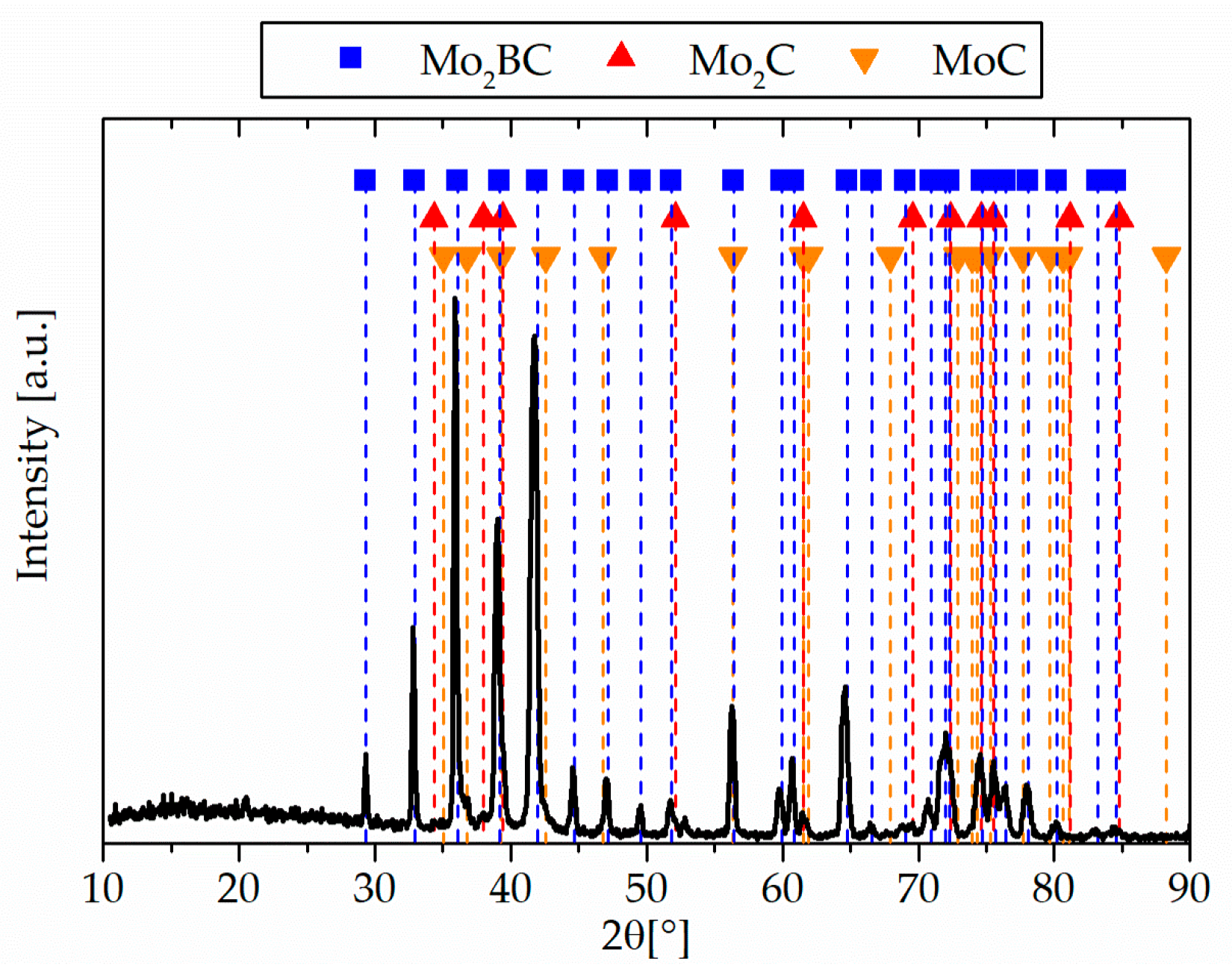
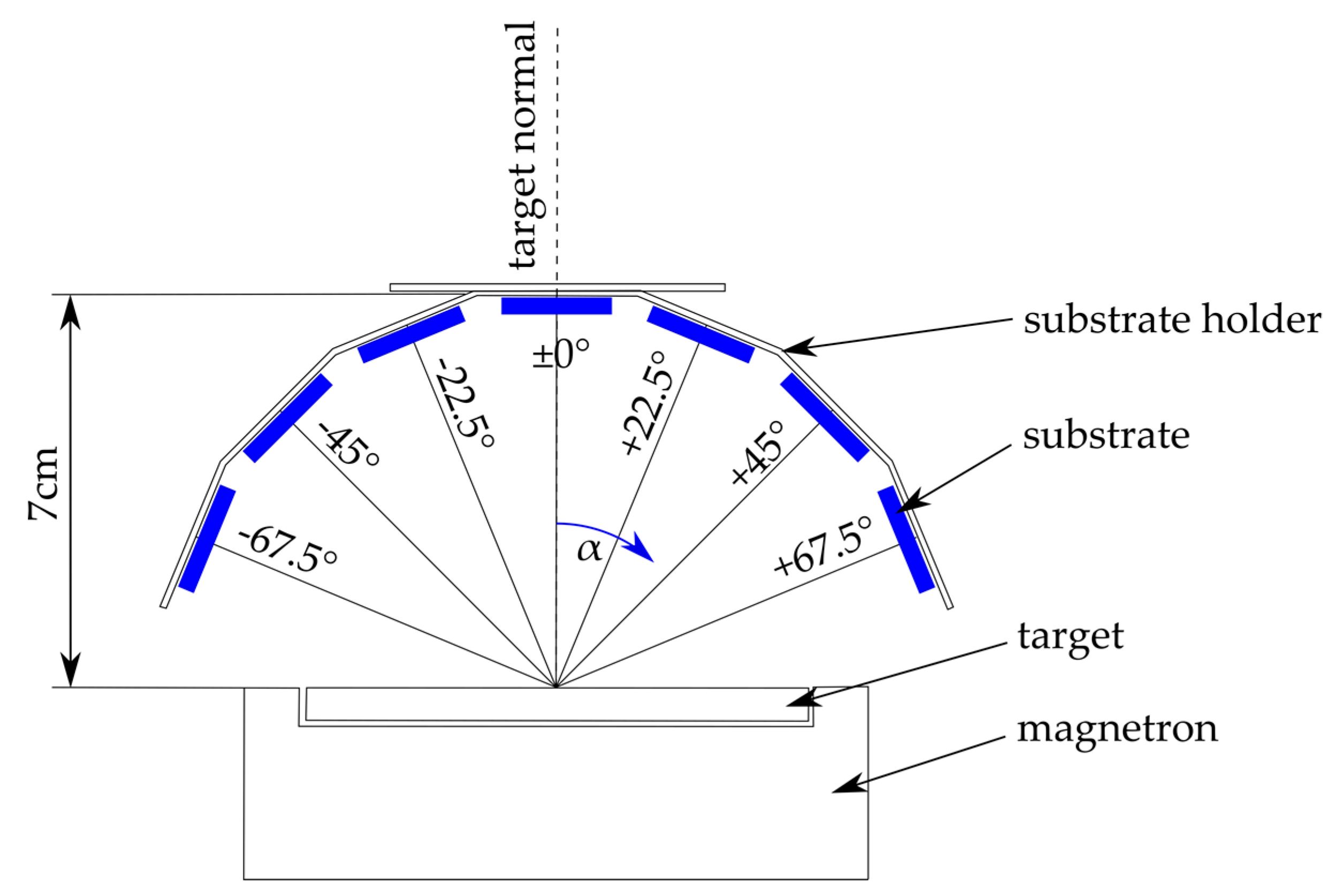
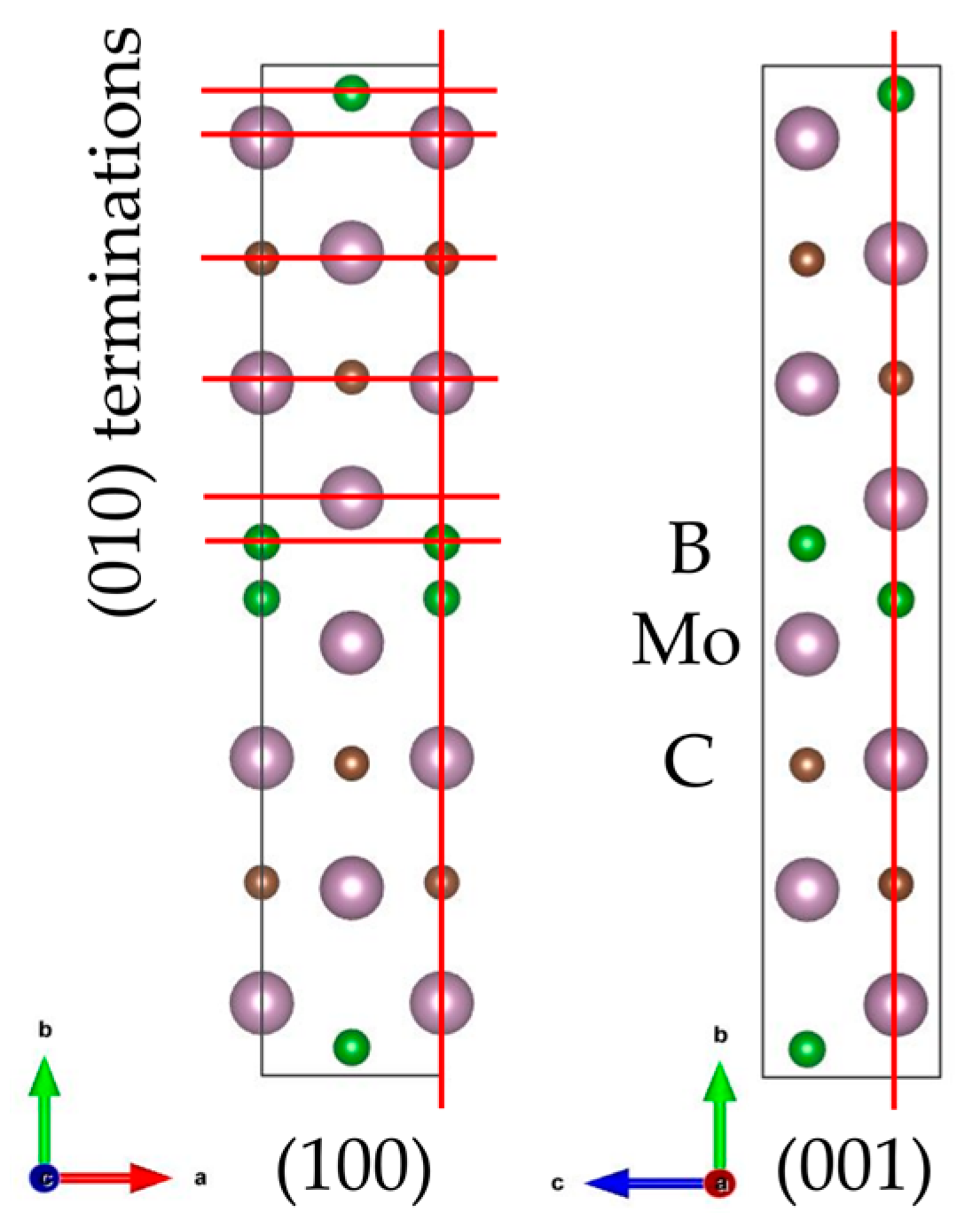
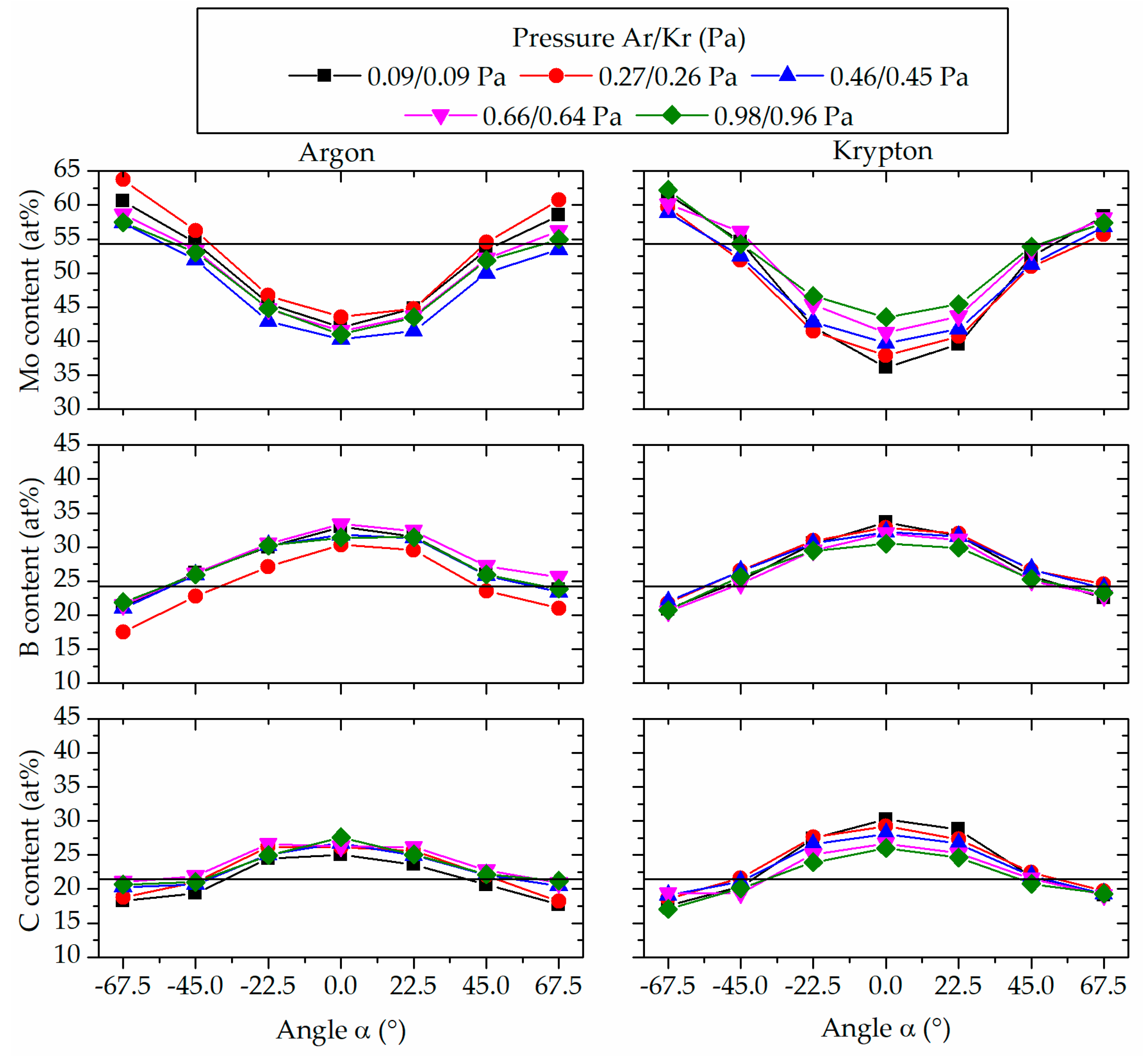
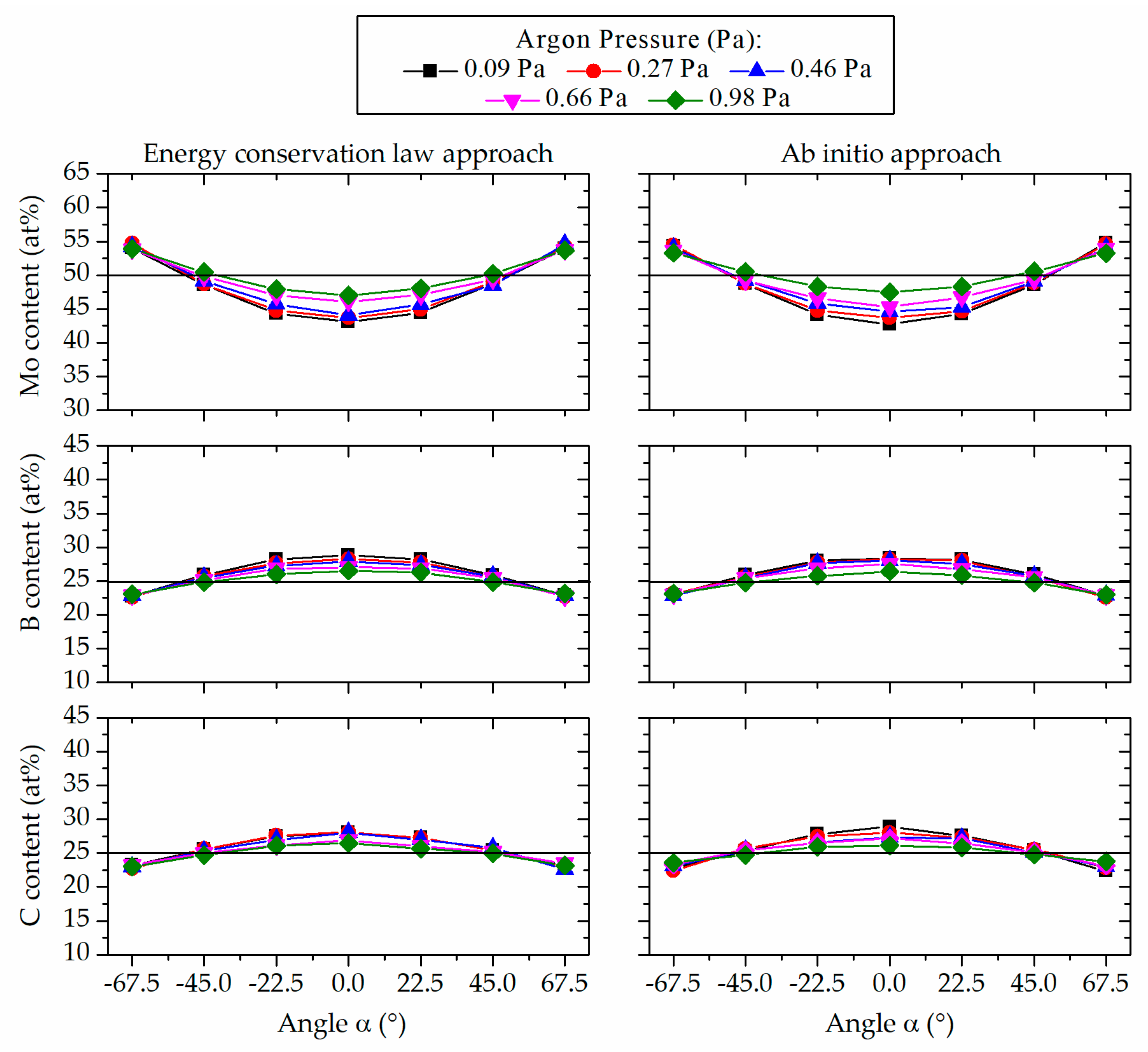

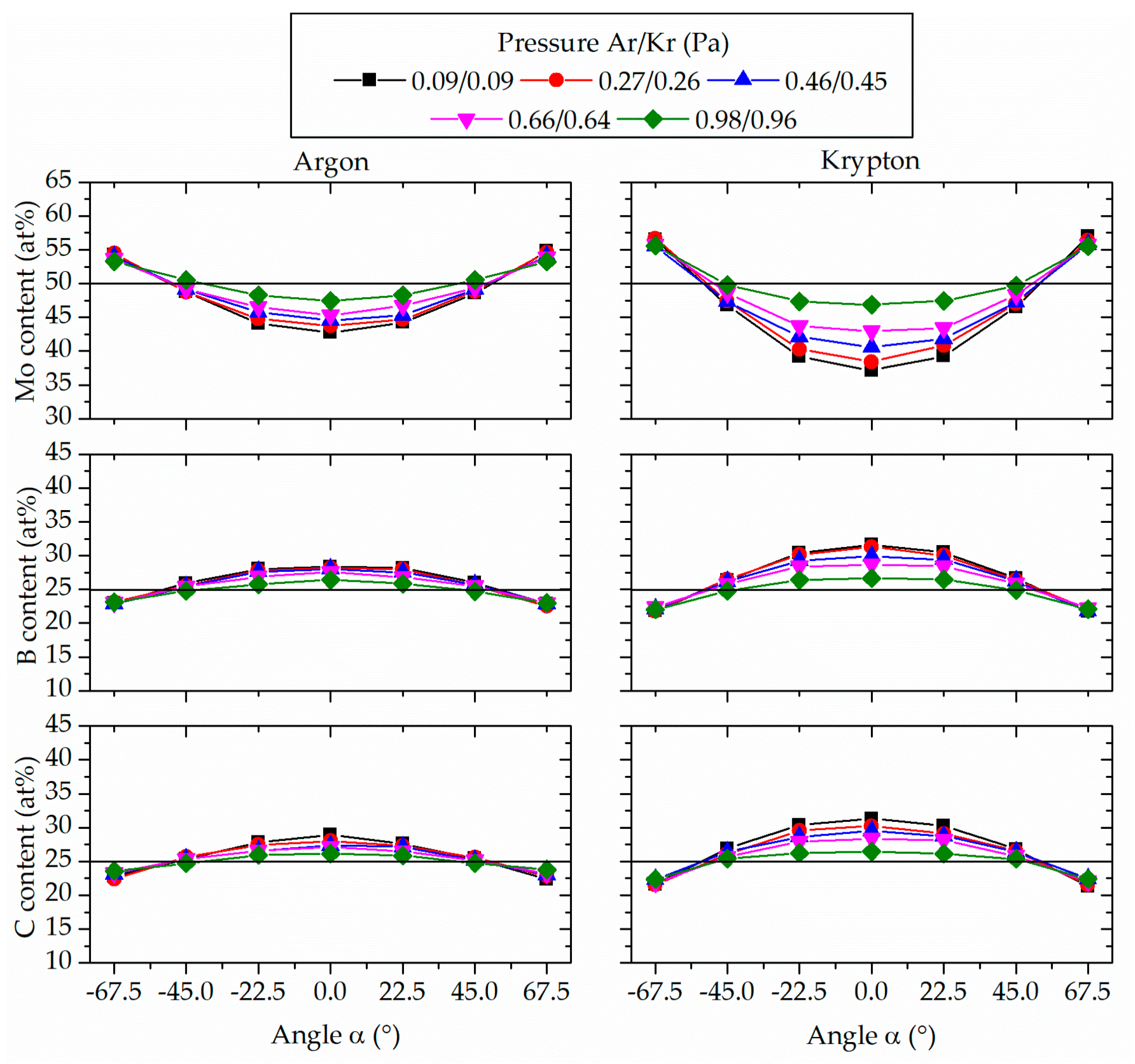
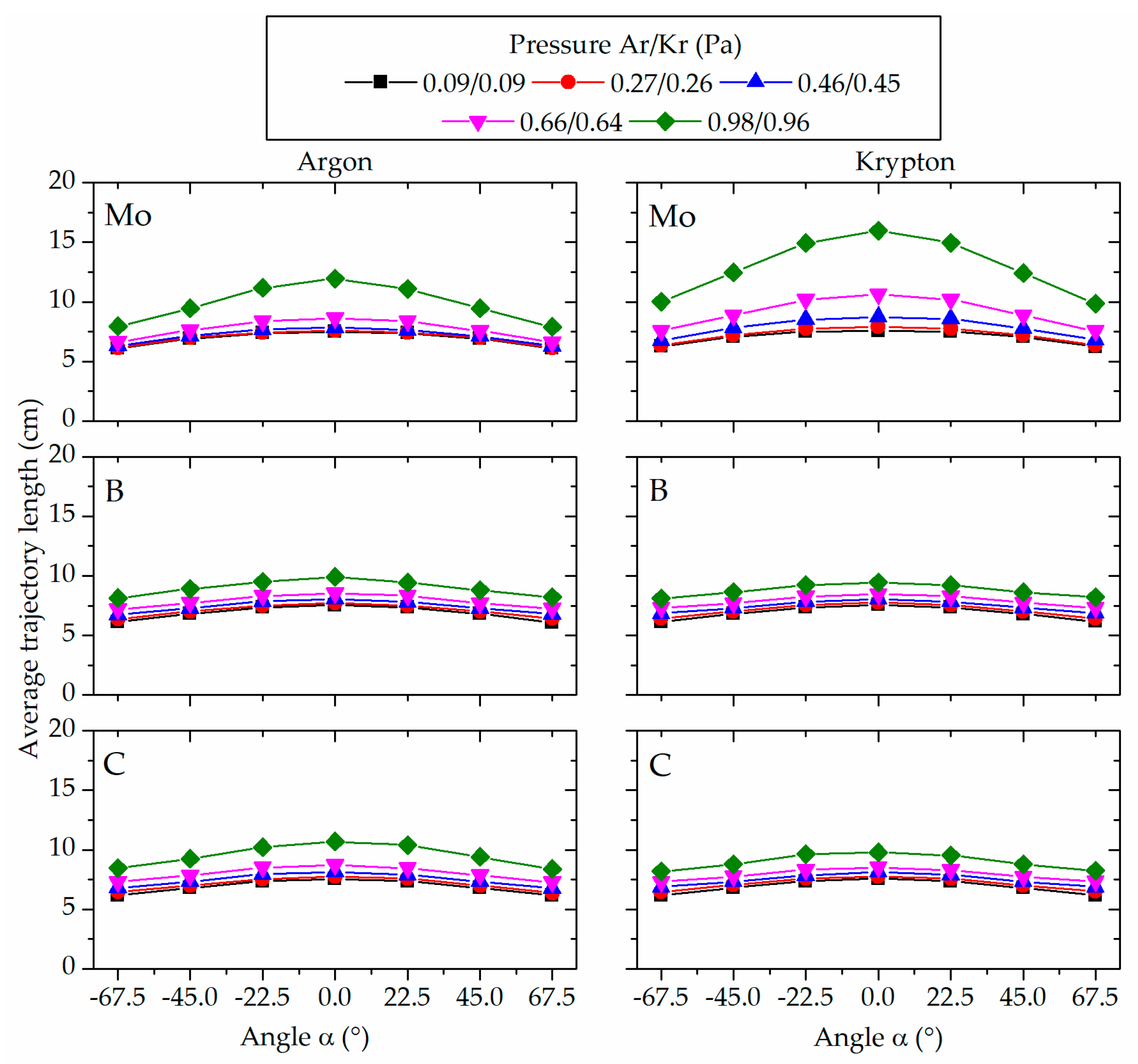
| Argon | Krypton | ||
|---|---|---|---|
| Pressure (Pa) | Voltage (V) | Pressure (Pa) | Voltage (V) |
| 0.09 | 401 | 0.09 | 441 |
| 0.27 | 344 | 0.26 | 423 |
| 0.46 | 328 | 0.45 | 421 |
| 0.66 | 324 | 0.64 | 418 |
| 0.98 | 314 | 0.96 | 403 |
© 2019 by the authors. Licensee MDPI, Basel, Switzerland. This article is an open access article distributed under the terms and conditions of the Creative Commons Attribution (CC BY) license (http://creativecommons.org/licenses/by/4.0/).
Share and Cite
Achenbach, J.-O.; Mráz, S.; Primetzhofer, D.; Schneider, J.M. Correlative Experimental and Theoretical Investigation of the Angle-Resolved Composition Evolution of Thin Films Sputtered from a Compound Mo2BC Target. Coatings 2019, 9, 206. https://doi.org/10.3390/coatings9030206
Achenbach J-O, Mráz S, Primetzhofer D, Schneider JM. Correlative Experimental and Theoretical Investigation of the Angle-Resolved Composition Evolution of Thin Films Sputtered from a Compound Mo2BC Target. Coatings. 2019; 9(3):206. https://doi.org/10.3390/coatings9030206
Chicago/Turabian StyleAchenbach, Jan-Ole, Stanislav Mráz, Daniel Primetzhofer, and Jochen M. Schneider. 2019. "Correlative Experimental and Theoretical Investigation of the Angle-Resolved Composition Evolution of Thin Films Sputtered from a Compound Mo2BC Target" Coatings 9, no. 3: 206. https://doi.org/10.3390/coatings9030206
APA StyleAchenbach, J.-O., Mráz, S., Primetzhofer, D., & Schneider, J. M. (2019). Correlative Experimental and Theoretical Investigation of the Angle-Resolved Composition Evolution of Thin Films Sputtered from a Compound Mo2BC Target. Coatings, 9(3), 206. https://doi.org/10.3390/coatings9030206





